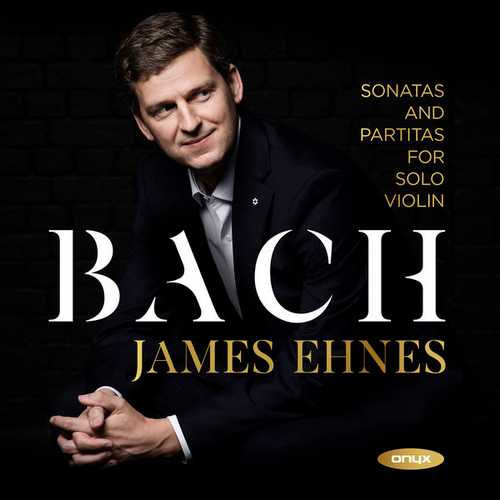

Composer: Johann Sebastian Bach
Performer: James Ehnes
Format: FLAC (tracks)
Label: Onyx
Catalogue: ONYX4228
Release: 2021
Size: 2.58 GB
Recovery: +3%
Scan: yes
Sonata for solo violin No. 1 in G minor, BWV1001
01. I. Adagio
02. II. Fuga (Allegro)
03. III. Siciliana
04. IV. Presto
Partita for solo violin No. 1 in B minor, BWV1002
05. I. Allemanda
06. II. Double
07. III. Corrente
08. IV. Double (Presto)
09. V. Sarabande
10. VI. Double
11. VII. Tempo di Borea
12. VIII. Double
Sonata for solo violin No. 2 in A minor, BWV1003
13. I. Grave
14. II. Fuga (Allegro)
15. III. Andante con moto
16. IV. Allegro
Partita for solo violin No. 2 in D minor, BWV1004
17. I. Allemanda
18. II. Corrente
19. III. Sarabande
20. IV. Giga
21. V. Chaconne
Sonata for solo violin No. 3 in C major, BWV1005
22. I. Adagio
23. II. Fuga (Allegro)
24. III. Largo
25. IV. Allegro Assai
Partita for solo violin No. 3 in E major, BWV1006
26. I. Preludio
27. II. Loure
28. III. Gavotte en rondeau
29. IV. Menuett l
30. V. Menuet II
31. VI. Bourrée
32. VII. Gigue
Among the various Gramophone Awards of 2021, one that felt especially perfect and inevitable was violinist James Ehnes receiving “Artist of the Year”. Arguably the recent culmination of his Beethoven sonata cycle might have been enough to clinch it by itself. Yet Covid lockdown had also seen Ehnes go above and beyond in terms of what he put out from his living room. Because while much of what was put out from musicians’ houses sat firmly in the bracket of “of its moment” – informal and impromptu, broadcast via whatever mobile devices they happened to own – Ehnes did something rather larger-scale: purchasing a pair of Telefunken M60 microphones with TK61 omnidirectional capsules; setting them up in his large, wooden-floored, emptied-of-furniture living room; then, in the small hours of the night when finally the world reached a sound-proofed-studio-esque degree of silence, filming and recording the complete solo violin sonatas of J. S. Bach and Ysaÿe. The result was one of the few filmed lockdown performance series whose production and artistic values gave them the mileage to become enduring works of art whose only obvious audible connection to those strange lockdown days is perhaps a heightened sense of emotional intensity. Of especially weighted surrounding silence. This past summer Onyx released his superb Ysaÿe sonata readings. Now here’s the Bach, which is Ehnes’s second recording of the set, the first having been stamped on disc exactly twenty years earlier, in 2000 with Analekta.
The first thing to say is that, while inevitably Ehnes’s readings have evolved over the years, they’re still recognisably from the same violinist. The generosity and impassioned drama is the same, with many of the changes being natural extensions of where he was going previously.
One clear difference from the off is the subtly different recording acoustic: a slightly brighter and more immediate quality, which acts as the perfect canvas on which to display the sheer polish of his technique; and everywhere is the sense of a violinist at the height of his technical powers. Another overarching point is that there’s a slight increase in tempi across the set, although often this only amounts to a few seconds. Essentially, it’s as though Ehnes has now lived so long and deeply in these works that they’ve truly become his own voice, and with the most impassioned thoughts, the pace naturally picks up. Consequently the virtuosity is perhaps more evident, and enjoyably rather than distractingly so.
Favourite moments. Well, I love the slight change to the emotional architecture of Sonata No. 1 in G minor’s Fuga. Previously, he began relatively big, as though we’d caught him mid-impassioned-conversation. Now it’s slightly more subdued, giving himself somewhere to go, which he quickly does. There’s also a slightly more delicately-voiced, lucid, wistful purity to his upper-register piano re-statement of the theme soon afterwards, and while these sound like small things – and really they are – it all adds up to an even more satisfying sense of architecture, and an even more developed and multi-nuanced emotional world. As for the famous D minor Chaconne, this appears via an as proudly non-period a reading as before in terms of his warm, rich, strong, soulful sound, but there’s also a bit more period-y air in some of the textures. Although both across the Chaconne’s show-stoppingly emotionally visceral yet supremely polished reading, and across the recording as a whole, cross-referencing quickly loses any attraction. For ultimately, these are performances of a power and beauty to simply lose yourself in, and be in the moment with.